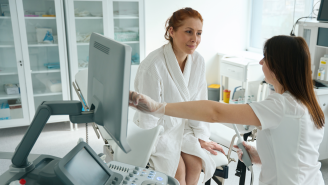Updated on April 16, 2024.
Approximately 19,710 women in the United States will be diagnosed with ovarian cancer in 2023, according to estimates from the American Cancer Society (ACS). But it may be possible to lower your odds of a diagnosis by making certain lifestyle changes. Melodi Reese-Holley, MD, an OBGYN at Omega OB/GYN Associates in Grand Prairie, Texas, offers science-backed ways to reduce your risk for ovarian cancer.
Know your birth control options
The ovaries are two organs that store and release eggs. They sit roughly on either side of the uterus. People who take birth control pills are less likely to develop ovarian cancer. In fact, taking a contraceptive pill for at least five years may decrease your risk of ovarian cancer by up to 50 percent, according to the ACS. Risk may be reduced for people at average risk for ovarian cancer as well as those who carry mutations in a gene called BRCA. Mutations in the BRCA gene increases the risk for ovarian cancer and breast cancer.
Birth control methods that decrease your total number of menstrual cycles may be especially protective.
“When you ovulate, it causes minor trauma to the surface of your ovaries,” explains Dr. Reese-Holley. “Some sources [like researchers at The University of Texas School of Public Health] suggest the inflammation and repair process that follows could lead to the development of cancer. That means birth control not only protects against unintended pregnancy, but also against this trauma that could cause ovarian cancer down the road.” The benefit occurs after about three to six months of use and continues even after you stop using birth control, she adds.
There’s been increasing evidence in recent years that intrauterine devices (IUDs) may decrease the chances of ovarian cancer, as well. IUDs are small devices placed inside the uterus for birth control. Their IUD use was associated with up to a 32 percent reduced risk, according to a 2019 analysis of studies published in Obstetrics & Gynecology.
Salpingectomy is a surgical procedure that involves removing one or both of a woman's fallopian tubes. It is performed to treat a variety of conditions and may also be used as a permanent form of birth control. A review of research published in 2023 in JAMA Surgery found that the procedure was associated with a nearly 80 percent reduction in the risk of ovarian cancer.
Be aware that birth control comes with possible side effects and it may not be right for everyone. Have a thoughtful discussion with your healthcare provider (HCP) about the pros and cons of each birth control method before deciding which one to pursue.
Don’t use tobacco products
Tobacco—and potentially, exposure to secondhand smoke—is linked to a particular type of ovarian cancer, along with many other health conditions, says Reese-Holley. For example, it’s associated with lung, breast, and cervical cancers, heart disease, as well as osteoporosis (a bone condition that weakens bones and can lead to fractures). When you consider all of the conditions for which it’s a risk factor, tobacco is the number one cause of premature death for women in the U.S.
For help quitting tobacco, speak with a HCP to see if your insurance may help cover the costs. You can also call the National Tobacco Cessation Line at 1-800-QUIT-NOW, which is available 24 hours a day and can connect you with additional resources and support in your area.
Don’t use baby powder
Talc is a mineral found in talcum and baby powders that may have a possible link to ovarian cancer. Some talc products naturally contain asbestos, which is a known cancer-causing substance. Since the 1970s, asbestos has been removed from all talc products on the U.S. market. Even so, research is mixed on whether asbestos-free products still pose a cancer risk.
“Some studies suggest that there could be an increased association between the development of epithelial ovarian cancers [the most common type of ovarian cancer] when talc products are applied directly to the genital area,” says Reese-Holley. Other studies have not found an association.
Any possible danger from talc-based products is likely small, but if you’re concerned, the ACS recommends limiting your use until more research is available.
Aim for a healthy weight
“Not only does obesity increase your risk of heart disease, diabetes, and high blood pressure, it can have large effects on your menstrual cycle, which is often underestimated by many people,” says Reese-Holley.
Your ovaries typically produce the two primary female hormones, estrogen and progesterone. But fat cells can also produce them.
“That extra estrogen can potentially increase stimulation of various organs and can increase your risk of developing cancers, such as ovarian cancer, breast cancer, and endometrial cancer (which affects the lining of the uterus). It could also lead to irregularities in your menstrual cycle and significantly heavier periods,” Reese-Holley explains.
Consider breastfeeding
People who breastfeed may be less likely to develop both ovarian and breast cancers.
“Many studies support a decreased risk with breastfeeding,” says Reese-Holley. “The degree of protection is actually proportional to how long you’re able to breastfeed. Women who make it to a year or longer experience the largest benefit.”
That amount of time is cumulative, so if you have multiple pregnancies, you can add up the number of months you breastfed in total.







